



Porcine Circovirus Type 2 Vaccination: Effect on Growth Performance and Carcass Characteristics
Porcine circovirus type 2 (PCV2) vaccination leads to reduced mortality, increased growth rate, inconsistent effects on feed efficiency and no impacts on carcass traits but the effects on nursery performance are product-dependent, according to Dr Steve Dritz of Kansas State University.Several studies have been conducted to evaluate the efficacy of porcine circovirus type 2 (PCV2) vaccines by using various criteria, including mortality rate, viraemia and co-infections, according to Steve Dritz of Kansas State University. In a paper presented at the 2012 Kansas State University Swine Profitability Conference, he stated that relatively little data has been available on the production impact of PCV2 vaccination on growth rate, feed efficiency and carcass characteristics, he continued. Over the last several years, it has been apparent that the production benefits of PCV2 vaccination are a major economic driver of the impacts of PCV2 vaccine.
In addition to the significant influence of PCV2 vaccination on decreasing mortality rate and increasing mean growth rate, the most significant finding was the shifting of the growth curve for the whole population of vaccinated pigs (Figure 1. Horlen et al. 2008). This indicated all pigs in a PCV2 infected group were affected by to some degree by the PCV2 infection. This study was conducted in a herd with readily apparent clinical signs of PCV2 disease during the finisher phase.
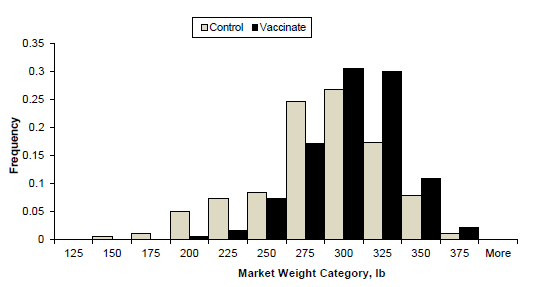
(Adapted from Horlen et al., 2008)
Additional, work has confirmed the influence of PCV2 vaccination on average daily gain with indications of an influence on feed efficiency (Table 1. Jacela et al., 2011). Growth-rate differences between non-vaccinated and vaccinated pigs peaked between the day 14 and 42 on test (Figure 2). The lower average daily gain in pigs without PCV2 vaccination preceded the observed rise in mortality, and the greatest difference in cumulative mortality between vaccinated and non-vaccinated pigs was noted between day 42 and 84 on test (Figure 3.).
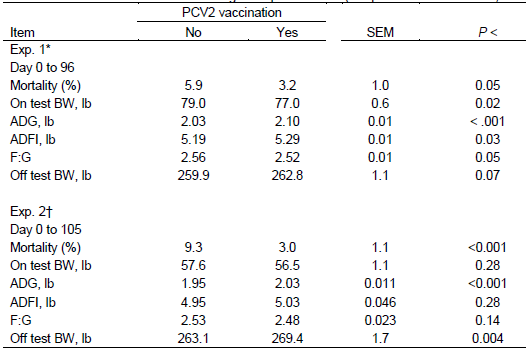
(Adapted from Jacela et al., 2011)
* A total of 1,291 pigs were randomly assigned to two treatments (Vaccinated and Control) within barrows and gilts. Commercial PCV2 vaccine (Circumvent; Intervet Inc, Millsboro, Delaware; 2mL per dose) was administered to Vaccinated pigs at 9 and 11 weeks of age.
† A total of 1,253 pigs (initially 5.5kg) were assigned randomly by nursery pen average weight before administration of the first vaccine dose of commercial PCV2 vaccine. (Circumvent; Intervet Inc, Millsboro, Delaware; 2 mL per dose) administered at 5 and 7 weeks of age to the Vaccinated treatment group (41 and 27 days before being placed on test in the finisher).
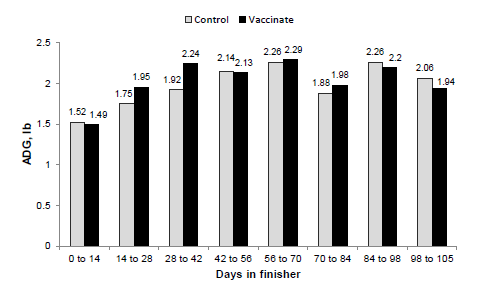
(Adapted from Jacela et al., 2011 Experiment 2)
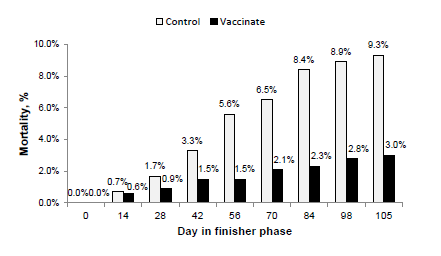
(Adapted from Jacela et al., 2011 Experiment 2)
The PCV2 vaccination in Experiment 2 from the study of Jacela et al. (2011) increased carcass weight as expected due to increased average daily gain. Note we were unable to detect impacts on carcass yield, back fat and lean percentage. However, there was a tendency for increased loin depth in vaccinated pigs. However, when adjusting loin depth to a common bodyweight, there was no difference in loin depth. Thus, the increased loin depth was simply due to having bigger pigs at the end of the study.

(Adapted from Jacela et al., 2011 Experiment 2)
* Values were adjusted to a common carcass weight by using carcass weight as a covariate in the model
In another field trial in a high health status boar multiplication farm without infection from PRRSv or detected infection with Mycoplasma hyopneumoniae (M.hyo), improvements in growth rate due to vaccination were detected (Table 3, Potter et al., 2011) The mortality from weaning to off test for the unvaccinated pigs was 7.0 per cent while the vaccinated pig mortality rate was 6.8 per cent. Active PCV2b infection without readily apparent clinical disease was documented during this trial. Another interesting observation from this study was that the increase in growth rate from vaccination was greater in the Duroc-based genotype than the Pietrain-based genotype. The magnitude of the difference in growth rate improvement from vaccination was over four times greater in the Duroc-based line than the Pietrain-based line.

(Adapted from Potter et al., 2012)
1 Results are reported as least squares means±SEM.
2 Genetic designations were A×A (Duroc line) and B×B (synthetic White Pietrain line) and their crosses. Data from crosses not shown
3 A circovirus vaccine (Circumvent PCV; Intervet/Schering-Plough Animal Health, Millsboro, DE) was administered intramuscularly (2mL per dose) to vaccinated pigs at 21 and 35 days of age.
4 Backfat and loin depth depth was adjusted to a common average off-test weight.
ab Within a row, means without a common superscript letter differ (P<0.05)
Back fat and loin depth were measured using real time ultrasound at 130 d after weaning. There was little impact on back fat and a tendency for increased loin depth in vaccinated pigs. However, similar to the results of Jacela et al (2011) when adjusting for differences in bodyweight there was no evidence that vaccination impacted carcass measurements.
In a large-scale commercial study designed to evaluate the interaction between dietary lysine requirements and PCV2 vaccination the improvements in growth rate during the grower phase were again confirmed with little impact of growth rate in the finisher phase when pigs had recovered and developed immunity from natural exposure (Table 4).
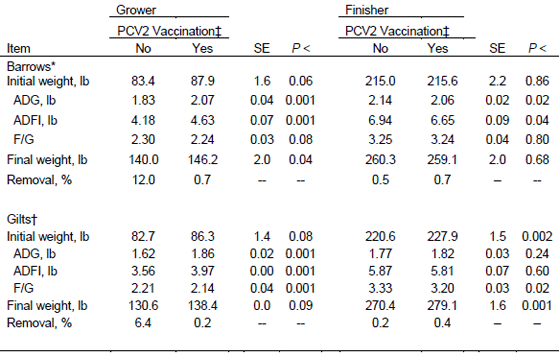
(Adapted from Shelton et al., 2012)
‡Vaccination for porcine circovirus (PCV2-Circumvent) was administered at one week post placement into the wean to finish facility and again three weeks later.
*Initially, 1,002 barrows (PIC 337 × 1050) were used in two 28-day trials (1 grower and 1 finisher) with 20 pen replications per treatment.
¥ The feed efficiency for the vaccinated pigs was adjusted for the differences in initial and final body weight using methods outlined in the Kansas Swine Nutrition Guide.
†Initially, 1,008 gilts (PIC 337 × 1050) were used in two 28-day trials (1 grower and 1 finisher) with 20 replications per treatment.
In the barrows, it appeared that there may have even been some compensatory gain in the unvaccinated pigs. Also, when adjusting for the differences in bodyweight due to the growth rate influences, there does not appear to be an impact of vaccination on feed efficiency. Note that bodyweight gain and pig days of removed pigs was used to calculate average daily gain and feed efficiency in this research trial as is standard practice in experiments designed to evaluate nutritional requirements. This is in contrast to calculations of feed efficiency in most commercial record-keeping systems that do not consider the bodyweight gain of the removed pigs in the calculation of feed efficiency. Thus, in commercial situations when comparing close-outs with differences in mortality rate, the higher mortality group will have a poorer feed efficiency just due to the elevated mortality.
In the research trial, the authors accounted for the bodyweight gain of the removed and dead pigs since they wanted to evaluate the efficiency of gain without the differences in mortality and removal rate. Although, a difference in mortality rate prior to and during the grower phase was shown, mortality adds variability that makes it difficult to interpret the impacts of disease on feed efficiency.
In the dietary lysine requirement portion of this study, the researchers showed advantages to increasing the standard ileal digestible lysine to metabolisable energy (SID Lys:ME) ratio that are similar to those reported by Shelton et al. (2008, 2009) and greater in magnitude than those previously reported in the same facility by Main et al. (2008).
There were no differences in optimal SID Lys:ME ratio between PCV2 vaccinates and non-vaccinates. However, the increased growth from increased average daily feed intake during the grower phase when clinical disease was most apparent suggests that PCV2 vaccinates have an increased daily lysine requirement on a grams per day basis than non-vaccinates from 90 to 130lb.
Also, as in other studies, there was little influence of PCV2 vaccination on carcass traits (data not shown). However, this study did indicate a significant reduction in feed intake and growth rate due to PCV2 vaccination during the nursery phase (Table 5).

(Adapted from Shelton et al., 2012)
‡Vaccination for porcine circovirus (PCV2, Circumvent) was administered at one week post placement into the wean to finish facility and again 3 weeks later. Each number represents means from 20 pens of pigs.
Although the improvements in removal and growth rate were readily apparent in the results from the large-scale commercial study of Shelton et al. (2012) there was a negative impact on growth rate and feed efficiency during the nursery phase (Table 6.). This effect was most pronounced during the immediate period after the administration of the second vaccine dose.
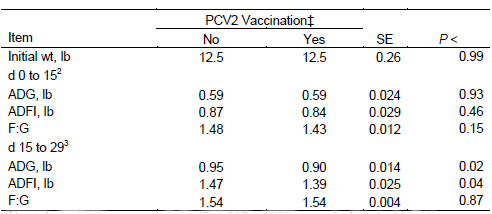
(Adapted from Shelton et al., 2012)
1 A total of 2,571 barrows and gilts (PIC 337 × 1050) were double-stocked into a wean-to-finish barn and observed for 50 days to determine the effects of PCV2 vaccine on growth performance.
2 The first PCV2 vaccine (Circumvent) was given on day 1 of this study to the selected pens of pigs.
3 The second PCV2 vaccine was given on day 22 of the study to the randomly assigned pens of pigs.
Therefore, based on the results of this study (Shelton et al., 2012) and due to field reports of PCV2 vaccination, the author and his team initiated a study to evaluate the impacts of nursery vaccination programmes on growth performance during the nursery phase (Potter et al., 2012).
In this study, the effects of vaccination for circovirus and M.hyo on nursery pig performance were evaluated in a 3 × 2 factorial arrangement. Main effects included circovirus vaccine and M.hyo vaccine. The circovirus vaccine treatments were: (1) no circovirus vaccine (non-circovirus-vaccinated control); (2) a two-dose vaccine, Circumvent PCV; and (3) a single-dose vaccine, Ingelvac CircoFLEX (Boehringer Ingelheim Vetmedica, Inc., St. Joseph, MO. The M.hyo vaccine treatments were: (1) no M.hyo vaccine (non-M.hyo-vaccinated control); and (2) a two-dose vaccine, RespiSure (Pfizer Animal Health, New York, NY). All vaccines were administered as separate intramuscular injections according to label directions (Circumvent PCV: 2mL per dose given on days 0 and 21; CircoFLEX: 1mL per dose given on day 0; RespiSure: 2mL per dose given on days 0 and 21).
There were no significant interactions between the effect of vaccination for circovirus and M.hyo vaccination (P>0.68). There was a tendency for pigs vaccinated with M.hyo vaccine to be 0.9lb per pig lighter at 35 days after weaning than those not vaccinated with M.hyo vaccine.
The circovirus vaccination reduced growth rate and pig weight on day 35 after weaning (Table 7). However, this effect was product- dependent, with the two-dose Circumvent vaccine accounting for all of the impact. Also, note that the impact on growth rate was a direct result of decreases in nursery feed intake with little impact on nursery feed efficiency. The impact was most pronounced after the second vaccine dose.

(Adapted from Potter 2012)
1 A total of 360 barrows were used in a 35-day study. There were 5 pigs per pen and 24 pens per circovirus vaccine treatment.
2 Circovirus vaccine treatments were: (1) Control: non-circovirus-vaccinated pigs; (2) Circumvent PCV: 2mL per dose of Circumvent PCV (Intervet/Schering-Plough Animal Health, Millsboro, DE) injected intramuscularly on days 0 and 21; and (3) CircoFLEX: 1mL Ingelvac CircoFLEX (Boehringer Ingelheim Vetmedica, Inc, St. Joseph, MO) injected intramuscularly on day 0.
ab Within a row, means without a common superscript differ (P<0.05).
These data suggest that vaccination with the second dose around the time of weaning should be avoided if using the two-dose product. Although there were no interactions between the circovirus and M.hyo vaccine impact on growth performance, the negative effects in Circumvent-vaccinated pigs were additive. Pigs vaccinated with Circumvent and Respisure grew 0.07lb per day slower and were 2.4lb lighter on day 35 after weaning than those pigs that did not have any vaccination during the nursery phase (Figure 4). Therefore, the potential negative impacts of vaccine usage during the nursery phase need to be balanced against potential disease control efficacy during the finishing phase. Also, when evaluating low nursery feed intake and growth rate, vaccination schedule should be evaluated as a risk factor.

In conclusion, results from these studies, according to Dritz, indicate the following effects of PCV2 vaccination on production traits:
- reduced mortality
- increased growth rate
- impact on growth rate is not limited to clinically affected pigs
- PCV2 impact on growth rate precedes impact on removal and mortality rates
- inconsistent effect on feed efficiency
- no effect on carcass traits, and
- product-dependent decrease on nursery feed intake and growth rate.
Literature cited
Horlen, K.P., S.S. Dritz, J.C. Nietfeld, S.C. Henry, R.A. Hesse, R. Oberst, M. Hays, J. Anderson and R. R.R. Rowland. 2008. A field evaluation of pig mortality, performance and infection following commercial vaccination against porcine circovirus type 2. J. Am. Vet. Med. Assoc. 232:906-912.
Jacela, J.Y., S.S. Dritz, J.M. DeRouchey, M.D. Tokach, R.D. Goodband and J.L. Nelssen, 2011. Field evaluation of a PCV2 vaccine on finishing pig growth performance and mortality rate in a herd with a history of porcine circovirus disease. J Swine Health Prod. 19:10-18.
Potter, M.L., L.M. Tokach, S.S. Dritz, S.C. Henry, J.M. DeRouchey, M.D. Tokach, R.D. Goodband, J.L. Nelssen, R.R.R. Rowland, R.A. Hesse and R. Oberst. 2012. Genetic line influences pig growth rate responses to vaccination for porcine circovirus type 2. J Swine Health 20:34–43.
Potter, M.L., E.M. Kane, J.R. Bergstrom, S.S. Dritz, M.D. Tokach, J.M. DeRouchey, R.D. Goodband and J.L. Nelssen. 2012. Effects of diet source and vaccination for porcine circovirus type 2 and Mycoplasma hyopneumoniae on nursery pig performance. J. Anim. Sci. Accepted for publication.
Main, R.G., S.S. Dritz, M.D. Tokach, R.D. Goodband and J.L. Nelssen. 2008. Determining an optimum lysine:calorie ratio for barrows and gilts in a commercial finishing facility. J. Anim. Sci. 86:2190-2207.
Shelton, N.W., M.D. Tokach, S.S. Dritz, R.D. Goodband, J.L. Nelssen and J.M. DeRouchey. 2008. Effects of increasing true ileal digestible lysine/metabolizable energy ratios on gilts grown in a commercial finishing environment. J. Anim. Sci. 86(E-Supp. 2):603. (Abstr.)
Shelton, N.W., M.D. Tokach, S.S. Dritz, R.D. Goodband, J.L. Nelssen and J.M. DeRouchey. 2009. Effects of increasing standardized ileal digestible lysine to metabolizable energy ratio on performance of 55 to 80 kg gilts in a commercial finishing environment. J. Anim. Sci. 87(E-Supp. 3):87. (Abstr.)
Shelton, N.W., M.D. Tokach, S.S. Dritz, R.D. Goodband, J.L. Nelssen, J.M. DeRouchey and J.L. Usry. 2012. Effects of porcine circovirus type 2 vaccine and increasing standardised ileal digestible lysine:ME ratio on growth performance and carcass composition of growing and finishing pigs. J. Anim. Sci. 90: 361-372.
Further ReadingYou can view other papers presented at the 2012 Kansas State University Swine Profitability Conference by clicking here.Find out more information on PMWS / PCV by clicking here. Find out more information on M.hyo by clicking here. |
January 2013








